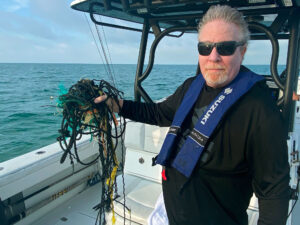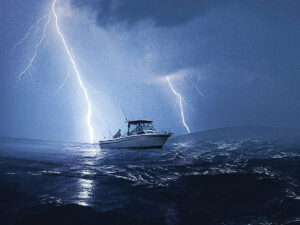You’ve daydreamed about cruising the indigo waters of the Bahamas, or perhaps battling blue marlin on St. Thomas’ North Drop or coasting among killer whales while watching glaciers calve at Alaska’s Kenai Peninsula. Wherever your nautical reveries reside, charters are likely available, but you bought a boat for the freedom to voyage. Unfortunately, time, or a boat’s capabilities, limit distance and routes.
But are those restrictions reality? Overland transport, semisubmersible or lift-on/lift-off yacht transport ships, and professional delivery crews can bring those far-off dream destinations within reach. To make your dream come true, we’ve collected the wisdom you need to on boat transportation so that you can cruise your own boat in exotic ports.
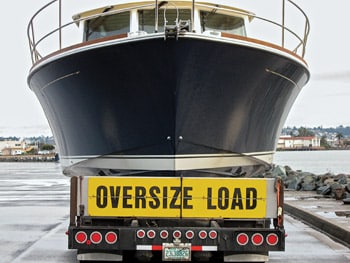
Over Land
If loading a boat on a tractor-trailer seems simple, dream on. “Hauling an oversize boat, it might take us seven hours just to get through Connecticut,” says Ken Follett, transport manager for Journey’s End Marina (journeysendmarina.com). “We have to go up, down, zigzag around, way out of the way.” And that’s only allowed Tuesday through Thursday, from 9:30 a.m. to 3:30 p.m., in good weather. Neighboring Massachusetts and New York have similar restrictions on different schedules.
To reach south Florida from Maine, it costs the owner of a boat not more than 12 feet wide or 13 feet 6 inches high (mast to keel plus trailer height), given the current average $4.25 a gallon for diesel, about $7,000. If this boat ran at an efficient 1 mpg, the fuel alone would cost what shipping does, and you’d have to add on dockage and food. The overland trip should take four days, versus a week by water. Trucking that same size boat to Seattle costs around $13,000 and takes seven days.
Complexity and costs grow with height and beam. “We can haul a boat 20 feet wide if we have the right road surveys and permits,” Follett says. “Over 15 feet wide, if you’re not out of Virginia by 2:30 p.m. on Friday, you’ll have to park until 9:30 Monday morning.”
Money isn’t the only factor when it comes to boat transportation. Overland transport opens otherwise unlikely cruising grounds. Scenery along the southern shore of Nova Scotia is stunning. But the world’s highest tides, frequent dense fog, icy waters and a shortage of facilities strain both a boat’s and crew’s abilities. Just 150 miles north by land, the protected, warm waters (approaching 70 degrees in August) along Nova Scotia’s north shore and surrounding Prince Edward Island create a saltwater playground. Boats under 50 feet abound, along with marinas, whales, seals and a mix of English, French and Gaelic culture.
Consider the hazards when choosing an overland carrier. “If a drunk runs a stoplight, that’s your boat’s insurance,” Follett says. “Our insurance covers our negligence.” Journey’s End carries $5 million in cargo insurance, which is separate from the truck and trailer policy. Have your insurer coordinate with the trucking company’s insurance provider to preclude loopholes.
Check a trucking company’s references from regular clients, particularly boatbuilders. Ask how they protect the boat from damage or theft while stopped at night, and inquire about equipment. “We have trailers that get the keel just six inches off the ground,” Follett boasted. “Trimming just an inch or two of height might easily save $1,000 in route surveys, permits, escorts and extra miles.” Hydraulic trailers can launch a boat, saving hundreds of miles just to reach a travel lift.
“Shrink-wrapping is good if it’s done right, but ripped shrink-wrap flapping down the highway at 65 mph will do more harm than good,” Follett says. Shrink-wrapping for travel requires different skills than winter shrink-wrapping, which is meant to shed snow.
“You really have to weigh out the cost of a delivery crew and fuel versus trucking,” Follett says. A boat exceeding 16 feet wide or 15 feet high, depending upon the state, adds dollars fast. Boats might be shortened by removing a radar arch, hardtop or even flying bridge — Follett suggests having the same workers handle those jobs at both ends, so start with a yard and have it suggest a trucking company. Journey’s End is both. “Give us a list, and we can paint the bottom, wax it, make repairs and deliver it to Florida, ready for you to turn the key and go.”
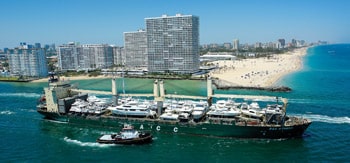
Yacht Transport Ship
For cruises to Alaska, the Mediterranean, the South Pacific or even the Far East, catch a ride on a yacht transport ship. “Our typical boat ranges from 40 to about 80 feet,” says Krista Kersey of Yacht Path Marine Group (yachtpath.com). “Those smaller boats are just as important to us as the megayachts.”
Dockwise Yacht Transport (yacht-transport.com) ships are semisubmersibles that ballast down allowing yachts to drive aboard. Divers block boats as the ship pumps water out. Because the company owns its ships, which carry only yachts, schedules are tight — a day or two of weather delay is the most expected.
Yacht Path leases deck space on ships carrying bulk cargo — perhaps grain, rubber or feed. Its teams fly to each port ahead of the ship to load and unload yachts using cranes. This gives Yacht Path flexibility to reach more destinations with more sailings, but also plagues those schedules with the vagaries of the shipping business. “We initially provide a 10- or 15-day window,” Kersey says. Once yachts are loaded at the first port, subsequent dates are firmer. “We’ll give daily updates, and then within 24 hours of arrival, we give an exact time and place for pickup,” she says.
But brokers and captains warn of delays when dealing with boat transport. “If the boat has to be there on a specific date, we’ll have a delivery crew on standby in case the ship falls through,” says George Sawley, a Fort Lauderdale yacht broker and globe-trotting sport-fishing captain (goldkeyyachts.com).
Sevenstar Yacht Transport (sevenstar-yacht-transport.com) falls somewhere between. Its parent company, Spliethoff, owns ships equipped to carry yachts in addition to below-deck cargo. Schedules seem tighter than Yacht Path’s, with more routes and sailings than Dockwise.
Shipping a 50-footer between Florida and Costa Rica averages $27,000 and takes a week on Yacht Path or Sevenstar. Dockwise costs more.
For comparison, Stalker, the 57-foot Spencer that Sawley often runs, makes the same trip in about nine days cruising almost continuously at 9 knots, burning one gallon per mile across 1,500 miles. Assuming $5 diesel and $2,500 for the Panama Canal transit, that’s $10,000, plus crew and customs costs. Running at 28 knots, the same trip takes about a week, triples fuel burned and adds more stops, each with customs fees.
Sawley suggests shipping one way and then cruising the return, perhaps fishing for billfish, dorado and tuna at Piñas Bay, Panama. “We might stop for a week in Coiba Island on the Pacific side, and then again at the San Blas Islands on the Caribbean side,” he says. “The dark coastal water and thick jungle in the Pacific contrast [with] the gin-clear Caribbean water, white sand and coconut palms on the Caribbean side” — distinctions not realized without transiting the canal.
For an eastern Caribbean cruise, “ship the boat to Martinique. The trip is always easier heading back toward Florida,” Sawley says of the southeast trade winds through the Caribbean, Turks and Caicos Islands, and Bahamas.
Besides saving engine hours, customs brokers referred by transport ships prearrange clearance, mitigating hassle. Specialty contractors typically complete shrink-wrapping — well worth the $30 per foot — at the marina beforehand.
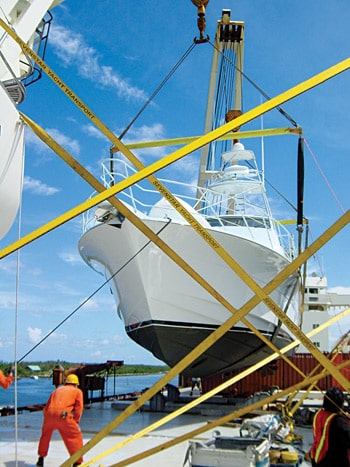
Delivery Crew
Transport ships typically don’t provide power, so perishables come aboard after unloading. Fuel tanks must be near empty. The same is true for overland transport. But a delivery crew can bring along provisions, top off fuel tanks and detail the boat. “I’ve even had dogs come along,” says John Wampler, who’s been delivering boats for decades (yachtaide.com).
Two crew average $500 per day combined plus their return travel. Wampler requests half the crew fee beforehand to cover his expenses, along with a credit card for fuel and dockage. Ask to see a sample expense report and negotiate meal per diem beforehand. When traveling overnight and far from shore, three or four crew keep minor inconveniences from becoming big problems.
Don’t think the delivery crew is there to fix problems along the way. Before the trip, clean the bottom, change oil and filters, stock spares and check safety equipment. Wampler carries an EPIRB, GPS, laptop chart plotter and VHF radio, but he insists on a working autopilot. “Hand-steering for 1,300 miles makes for long, mentally fatiguing days,” he says. “I’m not a prima donna. Fatigue causes most accidents.” It’s also reasonable for a pro crew to expect things like air conditioning during tropical deliveries, along with provisions for food preparation and hygiene.
Delivery crews tolerate rough seas, but reasonable conditions favor the boat. Consider contingencies.”If your son and daughter-in-law are headed to the Bahamas for their honeymoon, have the boat there early or plan a backup cruise to the Keys,” Wampler suggests.
Check references from owners of similar boats transiting similar waters; don’t rely solely on referrals from captains and brokers. Run background and credit checks. “You’re giving a guy the keys to your seven-figure yacht and a credit card with a six-figure limit,” Wampler says. Insurance falls to the yacht’s policy — ensure it covers waters to be transited and that the captain meets requirements.
Delivering a boat on its bottom adds wear and tear but also catches problems. It’s reassuring to know a pro skipper has pronounced the boat ready for that dream vacation before you step off the airplane. You might avoid sleepless nights.
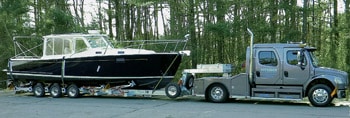
Money-Saving Secrets
1. Given your boat’s engines, rpm and speed, John Wampler estimates total cost — crew, dockage and fuel — at both cruising and displacement speeds; the latter saves big bucks on some boats.
2. Lower your fuel costs by coordinating with truckers to move your boat after they have dropped off another. That way you pay only one-way fuel costs.
3. Save up to 15 percent by booking transport ships three or more months in advance. This also increases risk of schedule changes.
4. Small boats might negotiate last-minute deals to fill gaps on deck.
5. Talk with delivery crews beforehand to see who pays for weather or mechanical delays. Wampler typically allows one unpaid lay day in a weeklong delivery.
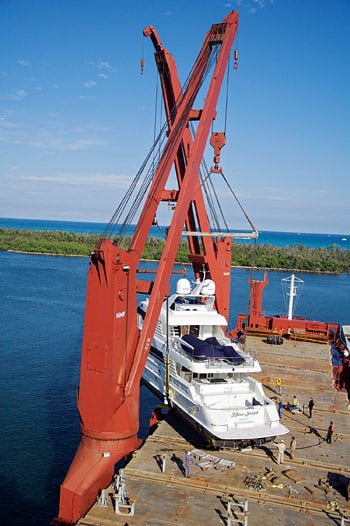
A Pro Skipper’s Advice for Loading Day
1. “Put every fender you have over the side, including a few well forward in case the stern swings out,” says Chris Leyden of SeaPort Yacht Services (seaportyachtservices.com).
2. While lift-on ships lower lines, be prepared to throw lines 10 to 30 feet up to the ship’s crew.
3. Shut down engines and generators right away so the ship’s divers can position lifting straps.
4. Leave fuel and through-hull valves open for quick starting when offloading.
5. Turn off batteries and apply shrink tape to leaky hatch seams.
6. Crack refrigerator doors open with packing foam and tape.
7. Secure everything for wind and rough seas.
8. Mark keys with the boat’s name and phone numbers, and bring a spare set to the offload.
Approaching a semisubmersible isn’t much trickier than entering a lock. “You’ll need your own lines, but they have lots of line handlers.” It’s not like the quick pace of lift-on boats. “Once you’re tied up inside the ship, you’ll have hours to secure the boat,” he says. — Chris Leyden, president of SeaPort Yacht Services

